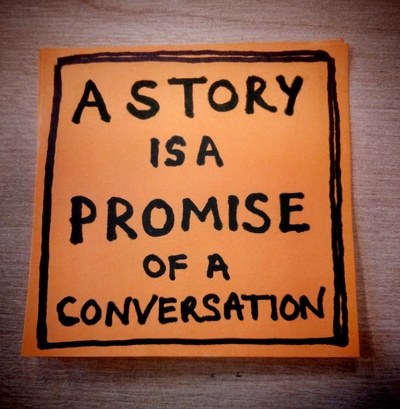Prior to the emergence of social networks, brand storytelling would typically unfold as a controlled narrative told from the perspective and interests of the business. Traditional media such as TV and print brought such brand stories to life and distinct traditions formed in how these stories were communicated and crafted. But the combination of absolute control, genre traditions, and format, have imposed limits in how such stories communicated and connected with audiences. Many of the brand storytelling themes that were once regarded best practice and believed to be meaningful, we know now is relatively ineffective in generating enduring customer interest and trust.
Thanks in great part to social networks, new traditions of storytelling for business/brands have evolved from what "THEY" the businesses, want people to know, to the stories that people care about. This shift has meant that businesses have had to learn (often times the hard way) that marketed information is not really communication, least of all a story worthy of inspiring engagement or conversation with others.
I've worked with brands for over twenty years. Admittedly, I have crafted my fair share of "traditional" stories for my clients. Over time though, I've come to recognize that certain kinds of stories are more successful than others in bringing business and people closer together. These stories succeed because of their ability to produce greater emotional and social engagement, and thereby story-sharing with others.
The following outlines seven strategies for how to evolve beyond mere information to a more human-centric approach to storytelling.
1) FROM Focus on Size and Stats TO the People Within - Employees are a company's greatest asset not because of the quantity employed, but because of the caliber of talent and added credibility they offer. Connecting audiences to more of the minds behind a company produces exponential wins and more opportunities for relationship building.
2) FROM Mass Media Push TO Building Engaging Relationships - Aggressive communication does not build attraction and interest, it repels. Social networks are a reminder that quality - not quantity, of connections is far more valuable.
3) FROM Demographics TO Understanding People & Communities - Categories and segmentation are intended to simplify data for application and use. But labels without context and deeper understanding tends to over-simplify information, thereby limiting development of true intelligence regarding people and their needs.
4) FROM Closed Culture TO Collaborative Social Business - Brands born out of an open social business culture will sustain growth far beyond those who rely on a closed, control-minded culture for innovation
5) FROM Leadership Authority and Title TO Leadership Vision and Influence - Social networks have redefined how we perceive leaders. Today, it takes far more than a title to earn the support and trust of followers. People look for reasons to believe before following.
6) FROM Stories of Product and Process TO Promise and Purpose - The source, sentiment, and substance of a story can determine whether it has staying power, or fail to even make an impression.
7) FROM Marketing Communication to Enabling Social Currency -The value of marketing communication is relative depending on its usefulness to people, be it informative, inspiring, social or otherwise.
Enduring and emotionally meaningful stories are grounded in share-worthy substance. Such substance is what makes both story and brand real and not marketing or sales proposition. Story worthy substance will often come in the form of response and action such as policy or business strategy. Such actions inspire storytelling by others thereby reinforcing a brand's authenticity and intent without ever requiring brand self promotion.
Great stories are timeless and lend themselves to revival and their own place in history. This doesn't mean that the content of a story, or the way in which it is conveyed, cannot evolve or be re-framed. On the contrary, when stories evolve in ways that connect people to bigger enduring ideals, even abstract concepts such as a brand can evolve to becoming a unifying and perpetual story/human link to others.


